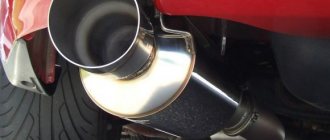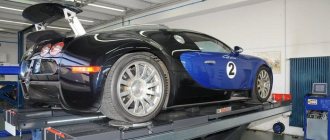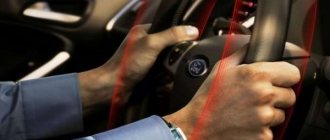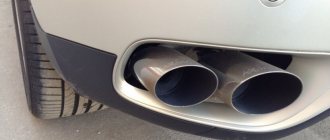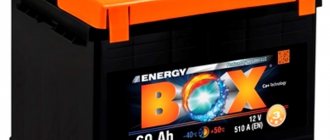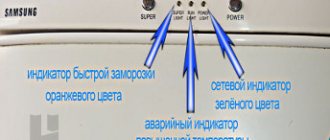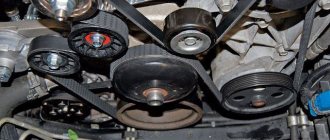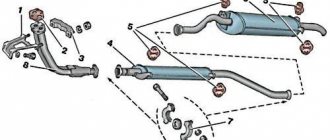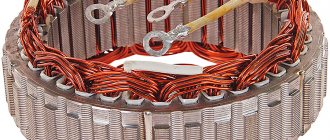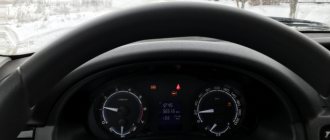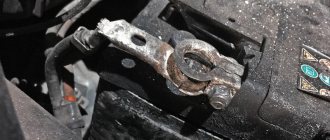Why does it shoot at the silencer?
The main reason that the engine shoots into the muffler is unburned fuel that has entered the exhaust system and ignited in it. The more gasoline leaks out, the louder the bang will be, and in some cases there may even be a whole series of “shots.” In turn, fuel can enter the exhaust system for various reasons. These could be malfunctions of the carburetor, timing belt, ignition system, various sensors (on injection machines) and so on.
The situation when someone shoots into the exhaust pipe can occur under different circumstances. For example, when over-accelerating, at idle speed of the engine or when relieving gas. As a rule, when there is a bang, a large amount of smoke . This malfunction is also accompanied by additional symptoms - loss of engine power, floating idle speed, increased fuel consumption. Let's look at the reasons why the muffler shoots in order, as well as methods for troubleshooting.
Carburetor in a motorcycle
It happens that the motorcycle shoots into the muffler and carburetor - this is often found on domestic Urals and imported choppers with a large cylinder capacity. The problem is a clogged air-fuel mixture at the inlet. To eliminate it, it is worth changing the filters and sealing gaskets, and also checking how tightly the pipes fit to the inlet fittings and whether there are any large cracks in them.
Very often, popping noises appear after replacing the muffler with a non-standard one or cutting holes in it to eliminate resistance to escaping exhaust gases. Particularly unpleasant sounds appear when installing a “direct flow”. The reason is the creation of a strong vacuum, which leads to a lean air-fuel mixture. Powerful imported motorcycles often use an exhaust gas afterburning system, which reduces their toxicity - after removing the standard muffler, its operation becomes clearly audible. To eliminate shots after changing the silencer, you must:
- Reconfigure the carburetor or reflash the control unit.
- Install filters with a different capacity.
- Disable the exhaust gas afterburning system.
On sports motorcycles whose engines run at high speeds, the problem with shots may be related to the speed limiter or crankshaft speed limiter. When a certain indicator is reached, the fuel supply may remain unchanged for some time, while the number of flares is reduced. Accordingly, a huge amount of gasoline enters the muffler, which explodes with a jerky sound, forming a “machine gun burst.” It can be heard especially well when releasing the gas after active acceleration. It is impossible to eliminate such a problem without reducing the life of the engine - you have to change your driving style so as not to irritate yourself and others with unpleasant loud bangs.
Clogged air filter
One of the reasons why muffler pops is an incorrectly formed fuel mixture. To create it, you need gasoline and a certain amount of air. It enters the engine through a system that contains an air filter at the inlet. If it is clogged, it does not allow a sufficient volume of air to pass through it, so the result is a kind of “oxygen starvation” of the engine. As a result, gasoline does not burn completely , and some of it flows into the manifold and then enters the exhaust gas removal system. There the fuel heats up and explodes. Because of this, a kind of pop is produced in the muffler.
Eliminating the cause of this phenomenon is not difficult. It is necessary to check the condition of the air filter and replace it if necessary. This is especially true if you haven’t changed the filter for a long time, but according to the regulations, such a procedure already needs to be done. This is the simplest problem why the muffler shoots. Let's move on.
Difficulty with ignition
This refers to a violation of the OZ or, more correctly, for the injector - UOTV. A broken injection angle leads to many problems, including popping noises in the muffler. And in this case we are talking about late ignition, when ignition of the fuel assembly begins only after the opening of the intake valve. The spark from the spark plug does not have time to ignite the fuel assembly by the end of the compression stroke.
Broken ignition marks
Thus, this facilitates the penetration of a certain part of the fuel into the exhaust system. The fuel explodes, creating a pop. Note that over time this leads to burnout of the muffler and the entire exhaust tract.
Surprisingly, popping noises can appear even with a properly configured ignition system. In this case, the cause is not the OZ, but the spark plug, which produces a weak spark. Also, the culprits of a weak discharge can be broken armor wires, ignition module, etc.
Candles deserve special attention. Experienced motorists can determine not only the performance, but also the nature of the problems in the engine based on the appearance of the element.
The spark plugs must be dry and have the correct electrode gap; there should be no traces of oil on them. The body of the spark-producing element should also not have any defects.
When replacing spark plugs, it is important to compare their heat rating with the engine model. This is extremely important, because otherwise there will be difficulties with ignition.
Carburetor not tuned
Often the reason that the engine shoots into the muffler is an incorrectly configured carburetor. Its task is to create a fuel-air mixture, which is then supplied to the engine. If it is configured in such a way that the mixture is oversaturated with gasoline, a situation similar to that described above is created. The solution here is to check and adjust the “carb”.
The first step is to check the fuel level in the chamber where the float is located. Each carburetor is individually adjusted and has its own level. However, if its cover is removed, the float should be flush with the level of the cover. If this is not the case, adjust the level. Also be sure to check the integrity of the float . If it is damaged, fuel may leak into it, causing it to display the level incorrectly.
The reason that the carburetor shoots into the muffler may also be the jets. They are either configured incorrectly or become clogged over time. If the air jet does not supply enough air, the mixture becomes oversaturated with gasoline with the result described above. Often this malfunction occurs when the engine goes from idle to higher speeds, or with a sharp increase in speed (acceleration). It is necessary to check the condition of the jets and clean them if necessary.
| Air/fuel ratio | Description | A comment |
| 6/1 — 7/1 | Extremely rich mixture. Ignition failure. | Rich mixture. Long burning, low temperature. |
| 7/1 — 12/1 | Overrich mixture. | |
| 12/1 — 13/1 | Rich mixture. Maximum power. | |
| 13/1 — 14,7/1 | Slightly enriched mixture. | Normal mixture. |
| 14,7/1 | Chemically ideal ratio. | |
| 14,7/1 — 16/1 | Slightly lean mixture. | |
| 16/1 — 18/1 | Poor mixture. Maximum efficiency. | Poor mixture. Fast combustion, high temperature. |
| 18/1 — 20/1 | Over-lean mixture. | |
| 20/1 — 22/1 | Extremely lean mixture. Ignition failure. |
Fuel mixture
Lean or rich mixture
Question: why does fuel get inside the cylinder? The answer is simple: a rich fuel mixture is the reason. And it is formed due to problems in mixture formation.
A little theory. It has been established that for flawless functioning, a car engine needs a mixture that includes the correct proportions. The proportion of gasoline should be fifteen parts of air. Thus, the NSS (standards of the stoichiometric mixture) is calculated. This is the best fuel assembly ratio at which the engine is able to produce enough power without taking a lot of fuel for this. This results in the most optimal and economical operating mode.
If the amount of air is reduced, for example, to 11-12 parts, this already results in an enriched fuel assembly. The motor, naturally, will produce more power, but it will also consume a lot. If you continue to reduce the air index, the mixture will already become over-rich. It should be understood that fuel assemblies with a 1x5 ratio are no longer flammable.
Why does the injector fire?
And vice versa. If you increase the air index or decrease the amount of fuel, the fuel assembly will become lean. Engine power will instantly drop, although efficiency will improve. The fuel assembly loses its ability to ignite if the ratio is 1x20. In addition, a lean fuel assembly does not contribute to fuel economy in all operating modes of the power unit. For example, when trying to climb a hill, the driver will press the accelerator pedal to get the desired output from the engine.
Thus, the proportions in fuel assemblies must be standardized. If there is more fuel in it than needed, the remaining amount of air will not be enough to ignite the mixture normally. The remaining fuel will enter the manifold through the outlet, then penetrate into the muffler, and at some point explode.
This happens especially often, as mentioned, on carburetor internal combustion engines, but injection engines are no exception in this regard. Often, lumbago occurs in the idle mode, during gas changes, etc. In both cases, it is important to find and correct the problem in a timely manner.
For example, the driver himself can carry out initial diagnostics, checking the quality of the fuel assembly by adding air to the system. If the shots stop after a while, then the problem is clearly in the air filter, which may be very dirty. It needs to be replaced and the air duct cleaned.
As a rule, in most cases it does not end with one filter. Injectors need more in-depth diagnostics. If it were a carburetor, then it would be possible to check the fuel level in the chamber on site, blow out the jets, etc. In injection systems, everything is much more complicated and it is recommended to carry out the check on professional equipment.
Article on the topic: How a hybrid engine works
Faulty ignition system
Another reason that the fuel burns incompletely and popping sounds from the exhaust pipe can be heard is that the ignition is not set correctly. In particular, if the ignition is late , then popping noises in the muffler at idle and at high speeds are inevitable. This fact is very simple to explain. A situation occurs when a spark appears at the moment when the supply valve has already fully opened, as a result of which part of the fuel does not have time to burn, but leaks into the manifold. And if the ignition is “early” , then it will “shoot” at the air filter.
Checking the spark plugs
Also, the cause of incomplete combustion of fuel can be a weak spark. In turn, this is a consequence of one of the facts:
- Poor contacts on high-voltage wires. It is necessary to inspect them and clean them if necessary. You should also check that there is no ground fault.
- Malfunctions in the operation of the distributor . It is also advisable to check its operation.
- Partially failed spark plugs . If at least one of them has exhausted its service life, this affects the power of the spark it produces. Because of this, not all fuel is burned. Check and replace spark plugs if necessary.
Carburetor
Quite rarely, the reason turns out to be precisely this. In this case, a shot occurs due to excess fuel entering the manifold and muffler. Most often, the reason is in the carburetor float chamber. Usually the needle valve fails. For a more accurate diagnosis, you will have to remove the spare part and completely disassemble it. Only then can you understand whether the valve is working or not. Often the cause is an incorrectly adjusted throttle valve.
In this case, a large amount of fuel simply does not have time to burn in the cylinder, and burns out in the exhaust system. The problem can be identified by the occurrence of popping noises when you press the gas. To eliminate this, check the adjustment of the cable that operates the throttle.
Incorrect thermal clearance
The thermal gap is the distance by which individual parts of the engine increase in volume when heated. In particular, it is between the valve tappets and the camshaft cams. An incorrectly set thermal gap is one of the possible reasons why the muffler shoots.
Indirect evidence of an increase in the thermal gap may be increased noise during engine operation, as well as a decrease in its power. If the gap is reduced, this may cause gases to shoot into the exhaust pipe. This occurs due to the fact that a valve that is not completely closed allows gasoline to enter the manifold, from where it then enters the exhaust system.
The thermal clearance of the cylinder head valves can be adjusted. Therefore, to eliminate this problem, it is enough to adjust the valves. This procedure is always carried out on a cold engine.
Faulty timing belt
Malfunctions in the operation of the gas distribution mechanism are generally similar to problems with ignition. In particular, the exhaust valve opens at a time when the gasoline has not yet burned out. Accordingly, it enters the exhaust gas removal system, leading to the already familiar popping sounds in the muffler.
There are several causes of malfunctions in the timing system:
- Timing belt wear . A sign of this malfunction is the appearance of additional metallic pops or noises when the engine is running at low speeds. In this case, you need to inspect the belt and, if necessary, tighten or replace it. You can read how to do this in the corresponding material.
- Worn toothed pulley . In this case, it is necessary to replace it.
- Partial valve failure . Over time, they become covered with soot (especially when refueling the car with low-quality gasoline), which leads to deterioration in the operation of the mechanism. And due to hanging valve springs, the engine overheats. Therefore, it is worth checking the valves. If you find slight roughness or bends on their surface, then grinding them in is a mandatory procedure. If the scratches are significant, you need to polish them or replace the valves.
Problems with injection cars
According to statistics, the problem of shots in the muffler is more often encountered by owners of carburetor cars. However, it can also occur with a fuel-injected car. However, their reasons for popping are different.
In such machines, the engine operation is controlled by the ECU based on information from numerous sensors. And if any of them gives false information, this leads to incorrect motor control. For example, if the air intake sensor is faulty, this will lead to incorrect formation of the fuel mixture. You should also check the crankshaft position sensor. If it provides information about a displacement of one tooth, this will also lead to incorrect operation of the system. The throttle position sensor, Hall sensor and other elements may fail.
The very first thing you should do is conduct computer diagnostics of your car. It will show which sensor or engine element is having problems. When the muffler is fired, it is also advisable to check the injector using computer diagnostics.
timing belt
Failure of timing settings can also lead to shots in the muffler. This phenomenon occurs due to the exhaust valves opening too early. Therefore, again, part of the burning fuel is pushed by pressure into the exhaust manifold. At the same time, these gases burn out with a fairly loud bang. This problem can often be found on the tenth family of AvtoVAZ. They have special recesses in the pistons that prevent the valves from bending in the event of a failure in the gas distribution system. The same reason can be observed in diesel engines. With this type of engine, when shots appear in the muffler, you should immediately check the timing drive.
If your car begins to actively shoot at the muffler, and you suspect a timing drive, then you need to eliminate the cause as quickly as possible. After all, any delay can lead to breakage of pistons or valves, that is, to a major overhaul of the engine. Most often, a failure occurs in the timing settings when the belt or chain is worn out. Therefore, check the condition of this engine consumable. If necessary, install a new drive.
Article on the topic “How to set timing marks.”
Additional reasons
There are a number of other reasons why the exhaust pipe shoots. These include:
- Popping noises when idling the engine are possible for two reasons - a leak in the intake manifold, as well as a clogged idle system.
- Poor quality gasoline or gasoline with a low octane number. Try to refuel at reputable gas stations and use fuel recommended by the manufacturer of your car.
- Mixed spark plug wires . If, when replacing or checking spark plugs, you mixed up the wires connected to them, this will also be a likely cause of popping noises. In this case, the car may not start and “shoot” at the muffler.
- If your machine has an economizer , check its operation. Often the malfunction of this unit is also the cause of “shots”.
- Malfunction of the air damper . Check this element and adjust if necessary.
- One of the reasons when the muffler shoots when releasing gas is that the muffler downpipe ( “pants” ) is poorly screwed to the exhaust manifold. Check the tightness of the connection and tighten it if necessary.
- Another likely cause of popping noises is high performance fuel injectors (“leaking”). They supply too much fuel, which does not have time to burn completely, which leads to “shots”. There is a simple way to check. It is necessary to try to start the engine at high engine speeds (with the gas pedal depressed) (the so-called purge mode). If popping noises occur at this time, it means that at least one injector is leaking.
- In injection cars, late ignition and, as a result, popping noises can be caused by “fatigue” of the knock sensor . It can also respond to extraneous noises occurring in the engine. The operation of the sensor must be checked using computer diagnostics.
- If the muffler shoots when releasing gas , then one of the most common reasons for this is “burning” of the exhaust valves. Popping noises may also appear when descending a mountain in gear. Inspect and clean them.
- If your car uses a contact ignition system, then you need to check the gap on its contacts . Ignition problems, as described above, may be the reason that not all of the gasoline is burned.
- Leakage of the gas exhaust system . In this case, as a rule, single pops occur when the gas is released. First of all, check the gaskets at the connections of the pipes (catalyst, resonator, muffler).
Also, if lumbago occurs and traction deteriorates, it is recommended to check the fuel pressure in the system, as well as compression (cylinder tightness for leaks), and inspect the ignition coil.
Condensation in the muffler
The main reason for the formation of condensation in the muffler is the temperature difference between the ambient air and the muffler. Its formation in a car with a working catalyst is a natural phenomenon. It’s worse if it’s not there, but too much can cause corrosion. There is a Read more
As you can see, there are many reasons why a muffler shoots. Therefore, we advise you to start your diagnostics by checking the tightness of the exhaust system. Inspect the bolted connections and gaskets between its individual elements. This will save you time and money. This is especially true if popping noises are heard when releasing the gas or when descending a mountain in gear (when braking the engine).
If the audit does not give positive results, then it is necessary to check the operation of the carburetor, valves and other parts described above. This check is advisable if the muffler shoots when you press the gas .
Carburetor and pops
Quite often it happens that popping noises in the exhaust system begin due to the fact that the carburetor was incorrectly configured. Its job is to create the correct fuel-air mixture, which is then supplied to the engine. If it happens that after adjusting it, it saturates the mixture too much with fuel, that is, gasoline, then the same thing as described above will begin to happen. That is, popping noises will begin to occur in the muffler when gas is released from the carburetor system. Naturally, the only correct way out in such a situation would be to reconfigure this element.
The first thing to do in this case is to check the gasoline level in the chamber in which the special float is located. It is important to know here that each carburetor is adjusted individually, and therefore each has its own optimal level. However, there is one common feature: if you remove the cover, the float should be flush with the level of the cover. If this is not the case, then you need to make adjustments. In addition, you should immediately check the integrity of the float itself. If it has any deformations, this can lead to fuel getting inside it, and therefore it indicates the wrong gasoline level.
View gallery
Another reason for popping noises in the muffler is the system jets. They may also be incorrectly configured or, if they have been in use for a long time, become dirty. In this case, the same thing will happen as happened with a dirty air filter. Jets are the same as air filters, with the only difference being that they are used in a carburetor system to create a mixture, and not in an injection system. Their clogging means that the amount of air entering the chamber decreases, and therefore the mixture becomes oversaturated with gasoline. Quite often, popping noises in the muffler at idle speeds occur after a sharp transition has been made from such speeds to higher speeds. In addition, the cause may be a sharp increase in speed, that is, excessive acceleration. If after any of these actions popping sounds appear, then you need to check the carburetor.
Popping sounds from cars with HBO
Unfortunately, this problem also affects cars that use liquefied gas as fuel. According to statistics, owners of cars with injection engines and third-generation gas equipment most often encounter it.
Gas pops can be heard both in the intake manifold and in the exhaust system (in particular, in the muffler). There are two main reasons for this:
- There is no stable and sufficient gas supply . This occurs due to incorrect settings of the gas reducer or a clogged air filter. For fuel-injected cars, the culprit may be the mass air flow sensor (MAF). “Glitches” in its operation lead to incorrect operation of the electronics. That is, we get a lean or enriched gas mixture, resulting in popping noises.
- Incorrect ignition angle . In this case, the situation is similar to that described above. If the ignition is late, the muffler “slams”, if it is early, the intake manifold or filter.
Monitor the status of your HBO and its settings. Don't neglect problems when they arise. Otherwise, you may not only face expensive repairs, but also spontaneous combustion of the car’s power unit.
Conclusion
Popping noises from the exhaust pipe are signs of a non-critical , but rather unpleasant “illness”. In addition to external manifestations, the engine and exhaust system deteriorate, and excessive fuel consumption occurs, which leads to unnecessary waste of money for the car owner. Also, if the problem is ignored for a long time, the valve, exhaust pipe, resonator or muffler may burn out. In general, if such a breakdown occurs the machine can be used , but it is recommended to carry out repair work at the first opportunity. If you cannot or do not want to do them yourself, contact a service station for help.
Shots from the exhaust tract are a malfunction inherent in the carburetor fuel supply system; on modern cars with an injector, it occurs much less frequently. In most cases, the car owner is able to cope with the breakdown on his own, without contacting a car service center. But first you need to make a diagnosis and determine why the engine is shooting into the muffler.
Claps with gas equipment
It is worth saying that this problem is also present in cars that use liquefied gas as fuel.
The cause of popping noises may be insufficient and unstable gas supply. Most often this is done either due to incorrect settings of the gas reducer or due to a clogged air filter. The reasons are similar to gasoline engines. The solution to the problems is also similar, that is, you need to either change the filter or reconfigure the gearbox. If gas is used as fuel, and the engine itself is injection, then the problem may be in the mass air flow sensor (MAF).
Incorrect ignition angle can also cause the popping sound. Here, in principle, the problem will be similar to that described earlier in a gasoline engine. With late ignition, cotton will be in the muffler, with early ignition - in the air filter.
Causes of popping
To successfully identify and correct such malfunctions, it is necessary to understand the origin of the shots. The popping sound occurs from improper combustion of fuel and is formed in two ways:
- In a combustion chamber filled with a combustible mixture, ignition occurred from a spark plug when the exhaust valve was open.
- Some of the unburned fuel penetrated the exhaust manifold and was ignited by hot gases emerging from the adjacent cylinder in the next cycle.
Note. Diesel engines also sometimes “sneeze”. Unlike gasoline engines, the shot is formed only in the combustion chamber (first option).
Shooting in an exhaust pipe is an unpleasant phenomenon and fraught with consequences. Micro-explosions often lead to the destruction of exhaust gas release elements - the resonator, muffler and expensive catalytic converter. Further neglect will lead to accelerated burnout of the valves. If your car starts making popping sounds or loud banging noises, it is recommended that you find and fix the problem as soon as possible.
In engines where the air-fuel mixture is prepared by a carburetor, the reason for the appearance of popping sounds lies in one of three main systems:
- ignition;
- fuel supply;
- gas distribution mechanism.
The order of systems in the list is not random. Such problems are most often caused by faulty parts of the ignition system, less often by the carburetor and timing belt. Severely worn engines may “sneeze” due to loose valves, but this is already a matter of major overhaul. Each group of problems should be considered separately.
Diesel and injector shots
In old-style diesel power units, the timing of diesel injection could be manually adjusted mechanically. If the settings were incorrect, the fuel was compressed too late and the diesel engine “sneezed” with white smoke. Nowadays, injection and diesel engines are controlled electronically, so firing from a muffler has become a rarity.
The main reasons why popping noises occur in modern engines:
- failure of one of the main sensors - mass air flow sensor, DBP, lambda probe or throttle position;
- severe contamination of the working surface of the crankshaft position sensor with metal shavings;
- problems in the high-voltage ignition unit;
- accumulated controller errors.
Advice. Electronics diagnostics is a complex issue that must be resolved by service station technicians. But you can reset the errors by disconnecting the battery for 15 minutes. Often, engine operation is improved in this way, but a check at a car service is still necessary.
When the power unit shoots into the muffler when releasing gas, the culprit may be automotive gas equipment. The installation that supplies liquefied propane to the cylinders is controlled by its own electronic unit and, in addition to the cylinder, includes valves with a reducer. If, as a result of a malfunction, the system begins to “overflow” gas, shots are inevitable. Such equipment should be handled by specialists; independent repairs are not allowed.
The appearance of characteristic loud pings in the exhaust system is a sign of a certain malfunction that requires immediate elimination. Ignoring this problem can further lead to serious consequences for the exhaust system elements, burnout or rupture of the muffler/resonator, problems with the catalyst and the engine itself.
Typically, dips and pops in the muffler occur spontaneously or only under certain conditions, during idling, during transient conditions, during sudden acceleration, etc.
In parallel with this, the driver may notice not only a short-term lack of response to pressing the gas pedal and subsequent popping noises in the exhaust pipe, but also a general decrease in engine power, deterioration in acceleration dynamics, and increased fuel consumption. Also, a problem of this kind is accompanied by difficulties in starting the internal combustion engine, after which popping noises in the muffler at idle appear after the engine starts idling.
In this article we will look at why popping sounds in the muffler occur when you press the gas, where the shots and popping noises in the muffler come from when cold and in other operating modes of a power unit with a carburetor and injection power system.
Read in this article
Installing the "dragon language"
To get a spectacular flame you need:
- Disconnect the car battery so as not to receive a strong current discharge during operation.
- Insert a candle into the exhaust pipe, at a distance of 10-15 cm from the “can.” In order for it to fit properly, you can weld it to the nut (or use simpler cold welding). If the flame ignites too close to the outlet, the “stunning effect” will not work. But if the candle is mounted before expansion (in a pipe with a diameter of about 50 mm), then the “dragon tongue” should be larger. In this case, the additional element does not have to be mounted from below; it can also be placed on the side.
Important! It is not safe to install the candle too deep.
- Install an ignition coil (the same as on the engine) next to the new spark plug. Additionally, it must be connected to a switch and a pulse generator. There will be two wires “+” and “-” coming from the structure, which need to be connected to the battery.
- Place the high-voltage wire coming from the coil onto the spark plug installed in the pipe.
- Bring a toggle switch into the salon. When you press one of its positions, the circuit will break, and the spark will go forward. The other position will be responsible for the standard supply of spark to the engine spark plugs. The flame should fly out only when the driver wants it, and not on its own.
Healthy! If the exhaust system is not direct-flow, but standard, then after the resonator you need to install an additional nozzle to supply the fuel mixture, which is connected to the gasoline pump. But then you will have to think over a valve that will shut off the fuel supply.
It is worth considering that great attention should be paid to wiring. Even “experienced” drivers do not always manage to make the correct connection. In this case, you can purchase a ready-made kit for creating a flame. As a rule, such products are accompanied by detailed color instructions, so they are much easier to install.
But, regardless of whether the “dragon tongue” is purchased or homemade, you need to know the intricacies of its use.
Causes of popping sounds in the muffler
The main reason that the muffler shoots is that some of the fuel from the engine cylinders gets into the exhaust system. Next, the fuel begins to evaporate, after which an explosion occurs in conditions of elevated temperature and confined space.
Shooting in the muffler can occur on both gasoline and, occasionally, diesel engines, as well as on engines with LPG. A carburetor engine shoots into the muffler; similar pops appear on engines with an injector. In other words, the problem is common to different types of internal combustion engines and quite common.
Rich air/fuel mixture
Let's start with the fact that most often problems with mixture formation and obvious over-enrichment of the fuel-air mixture lead to lumbago in the exhaust system. A little theory using the example of a gasoline internal combustion engine. As you know, for stable operation in any mode, the engine requires a working mixture of fuel and air. Such a mixture must consist of a strictly defined amount of air relative to part of the fuel.
It is generally accepted that for 1 kg of gasoline there should be 15 kg of air. This is a normal stoichiometric mixture, in which the ratio is 1:14.7. With this mixture, the engine produces enough power, while achieving good fuel efficiency.
Popping sounds in the muffler when releasing gas from carburetor and injection engines
Publication date: October 30, 2020.
“Shots” from a car muffler are quite a big problem, as they indicate a malfunction of the vehicle’s power unit. Most often, popping noises occur when the driver tries to start the car or when the engine speed is reduced. At this moment, unburnt fuel begins to leave the engine and ignites either directly in the engine or passing by the muffler resonator. When ignited, unburned particles expand at a tremendous speed, resulting in a loud “shot”.
Most often, owners of carburetor-type cars encounter such problems, however, in injection models, popping noises in the muffler at idle speed can also occur. First of all, let's look at the reasons why carburetor engines shoot.
Ignition problems
The most common reason for “shots” from the muffler is incorrect ignition settings, due to which the spark enters the cylinder late, that is, at the moment the intake valve opens, and not at maximum compression. In this case, part of the fuel is thrown into the collector with a rather loud “musical accompaniment”.
Healthy! The pops can be either constant or appear only occasionally. In any case, immediate diagnosis of the vehicle's ignition system is necessary.
If you ignore such problems, this can lead to burnout of the exhaust pipe and valve. Therefore, you need to check as soon as possible how the ignition timing is adjusted. If your car does not have such a regulator, then popping sounds in the muffler when you press the gas may appear due to a faulty ignition module or on-board computer.
The most accurate way to adjust the ignition is with a strobe light. To do this, connect it to the ignition system and start the engine (the speed should be minimal). After this, it is necessary to direct the strobe beam at the crankshaft flywheel, and make sure that the mark on the flywheel does not reach 0-2 divisions.
Another reason for “shots” is a weak spark. In this case, you need to check and adjust the spark plugs. To do this, you need to heat the car engine to its operating temperature and turn the distributor to set the ignition.
Healthy! It is possible that when changing spark plugs you mixed up the wires and installed them in the wrong order.
Violation of timing settings
Failure of valve timing settings and premature opening of exhaust valves can also cause the car to shoot out of the exhaust pipe. In this case, events develop in the same way as with ignition problems - part of the unburnt fuel enters the manifold under strong pressure and the burning gases provoke a loud bang.
Healthy! If the car has electronic timing control, then it is worth checking the electronics.
Owners of VAZ 10s and diesels most often encounter this problem. In this case, the popping noise appears only when the engine is warm. Since a timing belt failure can lead to quite serious consequences (breakage of pistons or valves), repairs must be made immediately. Otherwise, you may end up with a major engine overhaul.
It is also worth checking to see if the timing belt has slipped or stretched. It has special teeth with which the gear engages. If at least one of these teeth breaks off, the operating mode of the motor will be disrupted and, as a result, characteristic popping noises will appear.
Burnt valve
If the muffler shoots when you press the gas at low speeds, then most likely the problem lies in a violation of the valve's thermal clearance. The fact is that for stable operation of the engine, there must be a small gap in the place where the camshaft pushers contact the valve. It is needed for metal engine parts that expand slightly when heated.
If there is no such gap, then the valve will not tightly close the gap, which is why, at the moment of compression, part of the unburnt fuel will be pushed into the manifold. To avoid this, simply adjust the position of the valves or replace them.
Injection engine problems
Owners of cars with injection engines rarely encounter popping noises in the muffler. If such a problem does occur, then the reasons are most often the same as for carburetor-type cars - timing failure, incorrect ignition settings or broken thermal gap.
In addition, it is recommended to check the reliability of the contact sensors. If they do not work correctly, the electronic control unit will not distribute fuel correctly. It is almost impossible to identify such a malfunction on your own, so specialized diagnostics of the machine will be required.
In custody
Of course, you can operate a “shooting” car, but only if you are prepared to spend a lot of money, which will be required for subsequent car repairs. The same thing can happen if you ignore white, gray or black steam from the car muffler. In addition, critical malfunctions can also occur in the exhaust system, which can even lead to spontaneous combustion of the car. Therefore, do not delay the repair.
avto-moto-shtuchki.ru
Other causes of shots fired into a silencer
We add that in addition to the main reasons that were described above, popping noises during idle may indicate that the seal in the intake manifold is broken. One should not exclude contamination of the idle system and other malfunctions that can be eliminated by cleaning and adjustment.
On injection engines, as well as diesel engines with an ECM, failure of electronic sensors or disruption of their contacts can also lead to shots in the exhaust system.
We also note that the timely ignition of the mixture and complete combustion are also affected by the compression ratio in the engine and the general degree of contamination of the internal combustion engine. When compression is low, misfire may occur, causing unburned fuel to escape into the exhaust.
Also, the accumulation of carbon deposits in the combustion chamber often leads to the appearance of glow ignition, when the mixture ignites randomly from smoldering carbon particles. At the same time, the accumulation of deposits on the valves and in the area where the valve meets the seat can lead to its incomplete closure. As a result, fuel enters the outlet through the gap between the valve plate and its seat.
Conclusion
At the end, it is worth summing up all of the above. Firstly, popping noises in the muffler are a non-critical problem, but quite unpleasant, and it’s worth addressing it as quickly as possible. Secondly, in addition to external sound factors, there are also internal ones, which lie in the fact that the engine and gas exhaust systems will deteriorate. In addition, slamming means excessive consumption of fuel, which means an increase in the cost of purchasing it. When a car is used for a long time with such a problem, certain parts may burn out, which will completely disable the car and require more money and time for repairs. Popping noises in the muffler on an injection engine may not be eliminated without diagnostics.
What's the result?
As you can see, popping sounds in the exhaust system directly indicate the need to check the power system, electronic control system, ignition system and gas distribution mechanism. It should also be taken into account that further operation of a car with such a problem leads not only to the rapid failure of individual elements of the exhaust system, but can also cause burnout of valves, local overheating and other malfunctions of the power unit itself. Please note that quite often popping noises in the muffler cause vehicle fires.
Finally, we would like to add that to maintain the cleanliness of the internal combustion engine and prevent carbon formation, you should use high-quality motor oils and observe the recommended replacement interval for lubricants and filters. This is especially important for engines with hydraulic compensators. Also, in order to eliminate possible problems with thermal valve clearances, you should follow all recommendations regarding maintenance and repair of the power unit.
Safety Precautions and Cautions
First of all, you need to understand that self-installation of the “dragon tongue” is a change to the standard design of the vehicle. According to the letter of the law, this is only possible if the modification has been registered with the traffic police and does not violate the safe operation of the car. Of course, a flame from the muffler can only be attributed to changes that go along with malfunctions. Therefore, if you stage a “show” on the roadway and generally move around with flames coming from the exhaust pipe, you can “get” a fine.
Healthy! The use of straight-through mufflers (even without a flame) does not comply with environmental regulations.
Such demonstrations can only be held at special sites. In this case, the car must be at a sufficiently large distance from people and other objects that may catch fire. No turns can be performed. If something goes wrong, the driver must quickly leave the car. Therefore, it’s a good idea to have a fire extinguisher nearby.
It is also worth paying attention to the danger that such a system poses to the operation of the vehicle itself:
- If you do the installation yourself, there is a risk of damaging the exhaust system.
- If you do not limit the amount of gasoline supplied into the direct flow, the “spouting” of fire can result in an explosion.
- If a simple homemade system is installed on a car, this will lead to rapid wear and tear of the entire vehicle. Therefore, it is better to install fuses or even use a ready-made electronic system.
- If you turn on the flame often and for a long time, this will create increased thermal loads not only on the exhaust system itself, but also on other components.
- It is not always possible to control the escaping flames, the tongues of which can reach up to half a meter. In this case, there is a high risk of damaging the car's paintwork.
- If you turn on the “dragon tongue” for more than 3 seconds, there is a risk of serious damage to the power unit.
